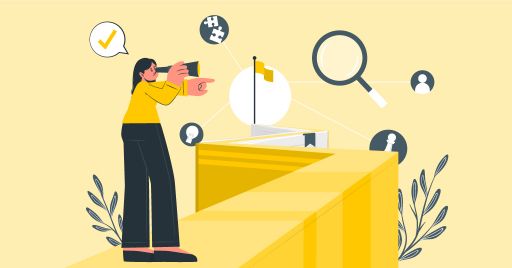
Learning paths: what they are and how they improve learning

Learning paths are changing the way training is done. Let's find out how this learning format improves the effectiveness of training programs
Without a map, reaching an unfamiliar destination can be very complex. And the same is true when starting a process of acquiring new skills or abilities: without clear objectives and defined paths, training is likely to be ineffective.
It is with this in mind that so-called learning paths are becoming increasingly popular in training.
Learning path: what it is
A Learning Path is a selection of courses grouped together for the purpose of progressively guiding the learner to the achievement of a goal, i.e., the attainment of mastery of a particular subject area or skill.
Unlike traditional courses, a learning path breaks down the learning content into easy-to-use blocks, offering the learner a navigable path through a series of eLearning activities that promote the achievement of the expected learning objective.
In other words, a learning path moves from the logic of a single training activity to that of a learning experience.
One of the distinguishing features of learning paths is flexibility, as they allow for the choice of learning modules and the most suitable level of depth. But that's not all: it is possible to make it so that when a user completes a specific module or course, he or she is automatically enrolled in the next one without the intervention of any administrator.
To be defined as such, a learning path must therefore include:
- a well-planned and outlined path
- specific milestones, usually linked to individual modules or courses
- clear and well-defined learning objectives
Types of learning path
There are several ways to construct a learning path, and each of these ways fits different objectives. To select the most effective learning path, it is therefore necessary to identify the goal of the training.
Let us look together at the most popular learning path types.
Sequential learning path
In this type of learning path, administrators create a series of courses structured in a predefined order. This means that the user must complete one course to access the next. If they do not complete a course or assessment, they will not be allowed to view subsequent modules.
Sequential learning paths are appropriate for courses that involve a transition from basic to advanced versions.
Calendar-based learning paths
This type of learning path combines the constraint of sequence with the constraint of time: the different courses that build the learning path are made available, not only on the basis of passing previous modules, but also according to a preset schedule.
Free-choice learning path
In this case, there is maximum flexibility: the student is provided with compulsory and optional courses, and he or she will choose which courses to complete and in what order.
For example, the user can be assigned ten courses to choose from, with the goal of completing five of them. The student will then decide which of the ten courses to complete.
Benefits offered by learning paths
Learning paths bring number of benefits to both the company and individual users. Let's discover them together.
Learner-centered learning
Learning paths have a learner-centered approach. With the ability to self-manage their learning path, users can choose when, where and how they learn.
Progressive development of knowledge and skills
Learning Paths enable the creation of a training program structure that works for groups or individual learners and facilitates the gradual acquisition of expected skills.
In addition, by providing an assessment at the end of each learning module, they allow you to ensure that the student has acquired the knowledge needed to move on to the next block.
Access to a variety of resources
A learning pathway allows a variety of resources to be offered to the student that meet different learning needs and adapt to different learning styles of users. For example:
- scenarios that introduce real-world situations with questions or challenges that allow the student to test what they have learned and receive immediate feedback
- tasks to be completed offline
- learning materials (guides, procedures, checklists, etc.) that the learner can refer to when needed, even while doing their own work
- tests to assess the level of learning achieved
Did you like this article? Sign up for the newsletter and receive weekly news!
Subscribe to NewsletterComments:
No comments are in yet. You be the first to comment on this article!